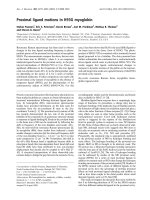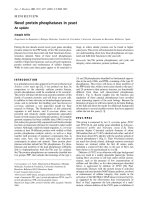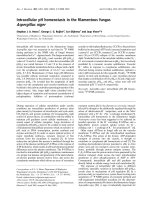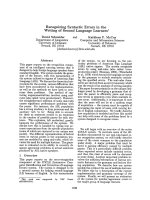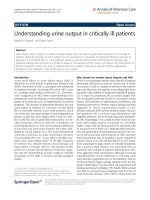Báo cáo y học: "Minimising drug errors in critically ill patients" pdf
Bạn đang xem bản rút gọn của tài liệu. Xem và tải ngay bản đầy đủ của tài liệu tại đây (111.52 KB, 2 trang )
Klopotowska and colleagues underscore the value of the
hospital pharmacists’ expertise in reducing medication
errors and improving patient safety in critical care [1].
e authors emphasise that drug inaccuracies are
frequent and that the limited physiological reserve of
critically ill individuals increases the potential harm of
adverse prescribing. Critically ill patients represent a
unique population with altered pharmacokinetics, and it
is likely that the rate of suboptimal prescribing may be
even greater than suggested by the current study [2,3].
Notably, Klopotowska and colleagues identifi ed that most
errors were focused on drug monitoring and suboptimal
and incorrect dosing; typically involving antibiotics,
drugs used less frequently in critical care and drugs with
rapid-change profi les such as anti-thrombotics.
It would have been informative to subcategorise errors
by clinical grade (intensivist, fellow, resident); however, it
is noteworthy that errors increased during the period
with new residents. Training is a central issue because
there are features unique to prescribing in this population
and residents require additional support. Residents are
integral to the processes that underpin many risk factors
for medication error [4]. From the outset of their critical
care experience, residents are required to prescribe drugs
not previously encountered and to chart drugs with
unfamiliar routes, rates and indications.
e impact of the limited pharmacy intervention
package described in this study [1] could be extended by
giving new prescribers an induction focusing on what is
unique to critically ill patients. is induction might be
delivered as an online resource, undertaken prior to
starting in critical care and reiterated as help boxes in
electronic prescribing.
© 2010 BioMed Central Ltd
Minimising drug errors in critically ill patients
Andrew Carson-Stevens*
1,2
, Christopher D Hingston
2
and Matt P Wise
2
See related research by Klopotowska et al., />LETTER
*Correspondence:
2
Adult Critical Care, University Hospital of Wales, CF14 4XW
Full list of author information is available at the end of the article
Authors’ response
Joanna Klopotowska, Peter Wierenga, Ameen Abu-Hanna, Loraine Lie-A-Huen, Margreeth Vroom and Susanne Smorenburg
We thank Carson-Stevens and colleagues for their useful
suggestions to improve medication safety in an intensive
care unit (ICU). As Dutch hospital pharmacists have
limited time for on-ward activities [1], additional measures
are needed to pursue 24/7 medication safety on an ICU.
An eff ective method to defi ne risks and prioritise
required measures has been developed in our hospital
[5]. Educational interventions such as (online) learning
modules for new residents, focusing on pharmacotherapy
in critically ill patients, could indeed reduce knowledge-
based errors [6]. e continuous change in the ICU
patients’ clinical conditions, however, necessitates con-
tin u ous pharmacotherapy evaluation. An audit and
feedback on pharmacotherapy by hospital pharmacists
could train new residents to cope with such complex
situations [7]. Based on the expected learning eff ect, such
intensive intervention is needed during the fi rst months
of the ICU rotation and could gradually be reduced [1].
Furthermore, for example, standardising prescription
of drugs that need frequent monitoring and/or drugs less
frequently prescribed in the ICU, and enhancing elec-
tronic prescribing by a clinical decision support system
(CDSS), could help to cost-eff ectively minimise skill-
based and rule-based errors [6]. e impact of CDSSs in
prescribing is especially pronounced in improving
adherence to guidelines [8] and could help prevent errors
due to drug–drug interactions, overdosing and drug–
drug duplica tions. Such a CDSS is currently under
construction in our ICU. A CDSS should, however, be
well designed in order to be eff ective [9].
Abbreviations
CDSS, clinical decision support system; ICU, intensive care unit.
Competing interests
The authors declare that they have no competing interests.
Carson-Stevens et al. Critical Care 2011, 15:401
/>© 2011 BioMed Central Ltd
Author details
1
Department of Primary Care and Public Health, School of Medicine, Cardi
University, CF14 4YS, UK.
2
Adult Critical Care, University Hospital of Wales,
CF144XW, UK.
Published: 11 January 2011
References
1. Klopotowska J, Kuiper R, van Kan H, de Pont A, Dijkgraaf M, Lie-A-Huen L,
Vroom M, Smorenburg S: On-ward participation of a hospital pharmacist in
a Dutch intensive care unit reduces prescribing errors and related patient
harm: an intervention study. Crit Care 2010, 14:R174.
2. Taccone F, Laterre P, Dugernier T, Spapen H, Delattre I, Wittebole X, De Backer
D, Layeux B, Wallemacq P, Vincent J, Jacobs F: Insu cient β-lactam
concentrations in the early phase of severe sepsis and septic shock. Crit
Care 2010, 14:R126.
3. Robinson S, Zincuk A, Strøm T, Larsen T, Rasmussen B, Toft P: Enoxaparin,
e ective dosage for intensive care patients: double-blinded, randomised
clinical trial. Crit Care 2010, 14:R41.
4. Moyen E, Camiré E, Stelfox H: Clinical review: medication errors in critical
care. Crit Care 2008, 12:208.
5. Wierenga PC, Lie-A-Huen L, de Rooij SE, Klazinga NS, Guchelaar HJ,
Smorenburg SM: Application of the bow-tie model in medication safety
risk analysis consecutive experience in two hospitals in the Netherlands.
Drug Safety 2009, 32:663-673.
6. Human Reliability [ />Understanding%20Human%20Behaviour%20and%20Error.pdf]
7. Ostini R, Hegney D, Jackson C, Williamson M, Mackson JM, Gurman K, Hall W,
Tett SE: Systematic review of interventions to improve prescribing. Ann
Pharmacother 2009, 43:502-513.
8. Eslami S, de Keizer NF, Abu-Hanna A: The impact of computerized physician
medication order entry in hospitalized patients – a systematic review. Int J
Med Inform 2008, 77:365-376.
9. Eslami S, Abu-Hanna A, de Keizer NF, de Jonge E: Errors associated with
applying decision support by suggesting default doses for
aminoglycosides. Drug Safety 2006, 29:803-809.
doi:10.1186/cc9366
Cite this article as: Carson-Stevens A, et al.: Minimising drug errors in
critically ill patients. Critical Care 2011, 15:401.
Carson-Stevens et al. Critical Care 2011, 15:401
/>Page 2 of 2




